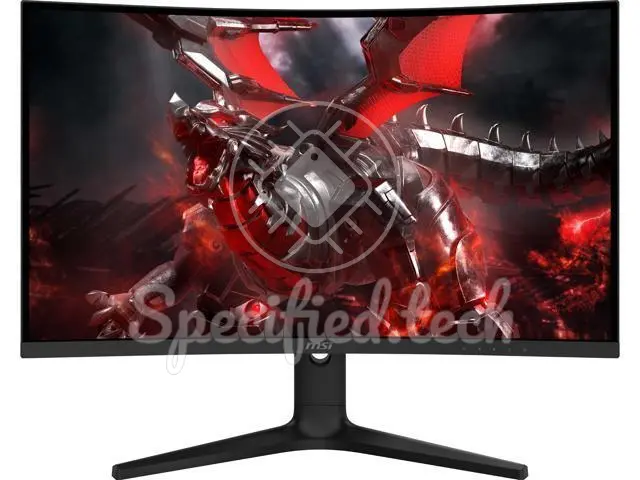
Today we will look at the monitor Optix G271C from MSI from the year 2022. Within this article, we will first take a closer look at the most important feature of a monitor -the display-, then the design, and in the next section we will go into the features of the monitor. Of course, power consumption, certifications, connectivity and other important details will also be considered.
Display
Any multimedia content can be displayed on 27 inches ( 68.4 cm on the diagonal). The size specification of a monitor refers to the screen diagonal, which is usually specified in inches. It is only comparable to a limited extent for different formats. For example, a conventional 4:3 monitor with the same screen diagonal has 6% less width, but 13% more height and a total of 7% more surface area than a monitor in 16:10 format. Despite the difference in working area, wider monitors are better suited for consuming games or current movies, for example. It is also easier to display several documents simultaneously on widescreen monitors. So, it depends on the current use case whether the aspect ratio of 1.778 : 116 makes sense for the intended use case. The display is a VA panel. The panel has a resolution of 1920 x 1080 px. The pixel density is 81 ppi. The pixel pitch is 0.311 mm. The continuous possible brightness specified by the manufacturer MSI is 300 nt. The panel is illuminated by W-LED. The built-in panel ensures stable color reproduction of the image, even at deviating viewing angles, by means of its 178 ° (horizontal) viewing angle. MSI promises stable color reproduction moreover within a 178 ° vertical angle. The refresh rate is horizontally seen at the Optix G271C 90.9 khz to 251.1 khz. Vertically, however, the image renews at a minimum rate of 48 hz up to 165 hz. The display panel is Anti-glare/Matte.
Color representation
The panel has a bit depth of 8 per color channel, but what does that mean? The number of bits determines how many colors can be encoded for the individual pixels of the display. For an 8-bit panel, for example, this is 256 different colors (2^8 = 256). However, since we usually display three different colors per pixel at the same time, in theory about 16 million (256^3) different colors are possible by mixing the three pixels. A 10-bit panel could even display a billion colors. According to the manufacturer, the coverage of the DCI-P3 color space is 90 %. According to the manufacturer, the coverage of the SRGB color space is 115 %.
Contrast ratio
Contrast ratio is a common measurement used to represent the maximum relative differences in brightness between black and white. It describes the ability of a screen or projector to produce a high-contrast image and is the quotient of the maximum and minimum displayable luminance. The higher the values are away from each other, the stronger the quantitatively seen difference between black and white is set up, which in turn results in an improved image quality. This monitor from MSI has a static contrast ratio of 3000 : 1 , according to the manufacturer. In contrast to the static contrast ratio, the dynamic contrast ratio changes the brightness of the panel itself in addition to the difference measurement from black to white. In addition to the difference between the brightest and the darkest pixel, the backlight is thus changed. Since the brightness of the panel may not be able to be adjusted exactly to a single pixel, a so-called halo effect is possible. The value of 100000000 : 1 of dynamic contrast ratio for the monitor Optix G271C cannot provide any information about the severity of the halo effect here. Therefore, it is more useful to compare the static contrast ratio.
HDR
The monitor supports all HDR modes listed here:
screen design
The size of the Optix G271C on the desk is likely to be particularly relevant for most users. MSI specifies a space requirement of 48.2 x 60.6 x 24.5 cm (HxWxD) with the included stand. The base itself has a depth of 24.5 cm. If you want to place the monitor on a table or even transport it, you should expect a weight of 5.6 kg with the stand screwed in.
Curved
The Optix G271C is a curved monitor with a curvature of 100 cm
Rotate, tilt and swivel
The monitor from MSI cannot be rotated. The monitor cannot be swiveled. This feature could be retrofitted with a third-party stand. The monitor Optix G271C offers the option of adjusting the tilt as required to create an ergonomic working environment and reduce visual fatigue. The angle of inclination to the rear is 20. The monitor can be tilted forward by 5 degree.
camera
This monitor does not have a camera.
Power consumption
The average consumption figure for Optix G271C is 48 w. In standby mode, the device consumes approximately 0.5 w. When switched off, on the other hand, the monitor consumes only 0.3 w. The monitor can be operated on a 110v power supply. The monitor can be operated on a 220v power supply. The power grid has to supply a frequency of 50 hz to 60 hz.
Packaging
The box together with the monitor weighs about 7.8 kg.
Further information
- 100x100
- 1.2a
- 2.0bcec

